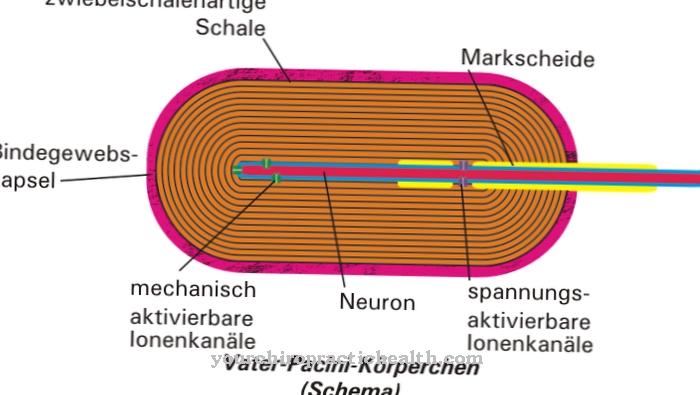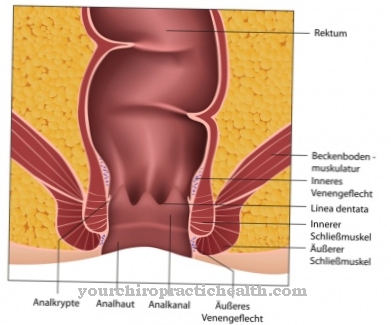The Eye chambers are formed by two cavities, the anterior and posterior chambers of the eye, and are located in the anterior part of the eye directly behind the cornea and in front of the lens. The two chambers of the eye are in communication with each other and are filled with aqueous humor, which primarily serves to supply the lens and cornea with nutrients and to maintain the necessary intraocular pressure.
What are the eye chambers?
The eye chambers consist of the larger anterior and the significantly smaller posterior chamber. The anterior chamber is located just below the cornea. Inwardly, it is delimited by the iris and the pupil muscles (musculus sphincter and dilatator pupillae) to narrow and widen the pupil.
It communicates with the lens and the posterior chamber of the eye via the pupil. The anterior chamber of the eye is bounded by the posterior aspect of the iris and pupillary muscles and towards the posterior by the front of the vitreous humor. This means that the iris and the pupillary muscles (smooth, vegetatively controlled muscle cells) form the main boundary between the posterior and anterior chambers of the eye. Both chambers are filled with aqueous humor, a crystal clear electrolyte in which proteins, hyaluronic acid, ascorbic acid (vitamin C) and other substances are dissolved.
Anatomy & structure
From an anatomical point of view, the anterior and posterior chambers of the eye do not have their own structure, which is delimited by a membrane, but are cavities that are created by the delimitation of other structures.
The anterior chamber is bounded at the front by the cornea, so that the aqueous humor in the eye chambers comes into direct contact with the cornea and an exchange of substances can take place between the cornea and aqueous humor. The posterior chamber is delimited to the rear by the front of the vitreous humor and to the center by the front of the lens. The ring-shaped ciliary muscles protrude from the outer edge of the posterior chambers of the eye and use zonular fibers to provide accommodation over long distances.
The ciliary muscles contain special cells that produce aqueous humor and release it into the posterior chamber of the eye. At the outer edge of the anterior chamber of the eye, an angle, called the chamber angle, is formed between the iris and the cornea. can smuggle in.
Function & tasks
In the two chambers of the eye and at their edges there are movable structures that are necessary for the accommodation of the eye, i.e. for changing the lens shape for setting sharp vision at long or short distances, and other structures whose task is to help the pupil, Depending on the intensity of the incident light, to be narrower or wider.
This means that the moveable and shape-changing structures on the one hand take up variable space and on the other hand other structures of the eye also require a certain pressure to keep the eye in the necessary shape. One of the two main tasks and functions of the two chambers is therefore to keep the required pressure, the intraocular pressure, at around 15 to 20 mm Hg (middle-aged adults) by regulating the production and drainage of aqueous humor.
The second main task is to supply adjacent structures that cannot be supplied with blood with nutrients and energy. These are primarily the lens and the cornea. The lens, cornea and vitreous body cannot be supplied directly via the bloodstream because a network of blood capillaries within the lens, cornea and vitreous body would "obscure the view".
The task is therefore taken over by the aqueous humor, in which the necessary proteins, hyaluronic acid, ascorbic acid and other substances are dissolved as electrolytes. Ascorbic acid is of particular importance because vitamin C, as a particularly effective antioxidant, counteracts oxidative damage caused by UV radiation and can thus prevent clouding of the cornea and lens. The vitamin C in the aqueous humor of the eye thus corresponds to a certain extent to "built-in sunglasses".
You can find your medication here
➔ Medicines for visual disturbances and eye complaintsDiseases
One of the most common diseases that can be associated with malfunction of the eye chambers is glaucoma, also known as glaucoma. One of several high risk factors for developing glaucoma is increased intraocular pressure. The increased intraocular pressure can occur if the trabecular framework in the anterior chamber is restricted in its function and cannot drain enough aqueous humor.
If the production of aqueous humor in the ciliary bodies in the posterior chamber is unchecked, a kind of congestion occurs in the eye chambers, which can cause glaucoma. Glaucoma leads to gradual destruction of the optic nerve head, which can lead to visual field defects. Green star is one of the most common causes of blindness worldwide. The main cause of glaucoma is a disproportion between blood flow to the optic nerve and intraocular pressure.
If there are circulatory disorders in the optic nerve, normal intraocular pressure can trigger the disease. Loss of aqueous humor due to injury or after an operation can be similarly problematic. If the loss is not made up, the choroid will swell, which is associated with significant visual disturbances. If the lens capsule is mechanically damaged, aqueous humor can penetrate the lens, which leads to swelling of the lens cortex and makes accommodation of the lens more difficult.



























